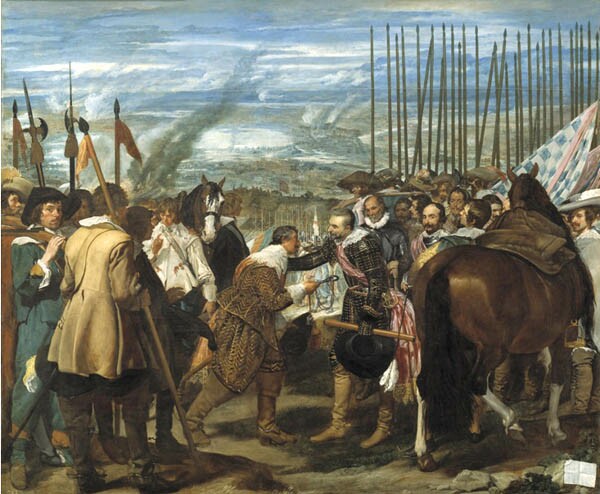
The Surrender of Breda
|
One of the famous paintings of Velasquez, the 17th century Spanish painter, is The Surrender of Breda. When I was a boy, I entered a store with art prints and came across a picture of this historic incident. I was immediately captivated by it. After contemplating the scene for some time, I thought: "I would like to have this picture so I could spend hours looking at it and admiring it!"
It is indeed a magnificent canvas, not only for the rich pictorial that demonstrates well the exceptional talent of the master, but also for the beautiful expression of moral values that it portrays.
The episode is superbly immortalized: The Marquis de Spinola, commander of the troops of King Philip II, receives from the hands of Justinus van Nassau, defender of Breda, the keys of the city, which surrendered on June 25, 1625, after an intrepid resistance.
The General of the Catholic King is wearing an impressive armor; a lace collar gives it a note of amenity, further enhanced by the large sash typically worn by a Commander in Chief. In his left hand, one notes the Marshall’s baton. The conquered General Justinus von Nassau also has a rich costume, with ornate lace collar and cuffs.
The scene takes place in the countryside in a strict military atmosphere that includes troops, arms in hand. Notwithstanding, the meeting has a note of distinction and affability suggestive of a ballroom scene. Justinus van Nassau, since he was defeated, presents himself hat in hand and slightly bowing as he delivers the keys of the city. Spinola, out of respect for the valiant opponent, also has his head uncovered. Behind him, the knights of his entourage imitate him.
One can see that the victor inclines forward slightly and with one hand respectfully restrains the reverent bow of the Dutch noble; his countenance is suffused with sympathy and consideration. One perceives that he is congratulating his opponent for the brilliant resistance, thus cavalierly easing the bitterness of the act of surrender he is making.
A whole doctrine of courtesy, a whole tradition of nobility of soul, is expressed in the discreet but eloquent details of this remarkable picture. An elevation of soul that comes from faith, a courtesy born of charity, which cause inestimable spiritual values to shine in an act that is, in itself, inevitably harsh and humiliating, like any surrender.
It is interesting to note that the light rose-colored – almost lilac – sash adorning the breastplate of the Spanish General was a reminder of the death shroud, since military leaders of that epoch left for combat keeping in mind that they might die, sacrificing their lives for the cause of their country.
So, this man presents himself at the scene where his courage and victory will be recognized, wearing on his breast the symbol of his shroud. He does not tremble or hesitate, and if he maintains a posture that is one of both triumph and goodness, this would not be possible, in my view, without a special action of grace. For attitudes like this are only possible within the ambit of the supernatural that confers light and splendor to Christian Civilization.

Translated from Catolicismo, November 1956
Posted September 1, 2012
|